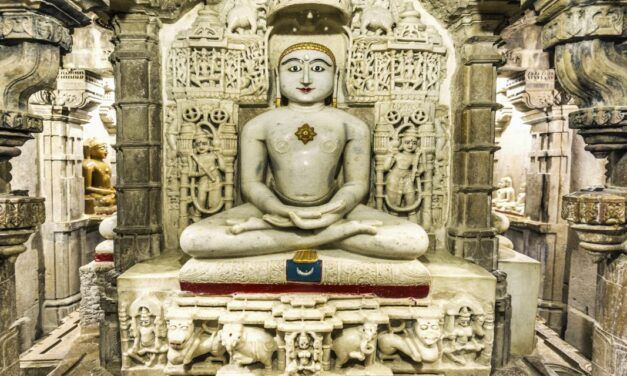
A movie review of
Star Wars: The Last Jedi
Directed by Rian Johnson
(Rated PG-13, 2017)
Editor’s note: We realize that interpretations and reactions to storyline elements and their ramifications have been hotly debated. We offer this review as one plausible viewpoint.
Theoretically, “the Force” in the Star Wars movies has always been religious. It is referenced in terms of religion at least twice in the original 1977 Star Wars (a.k.a. Episode IV: A New Hope). But in practice, there is not much religion in either the original trilogy or the prequel trilogy (Episodes I to III). Yes, as they train the young Luke Skywalker in the ways of the Force, the elderly Jedi masters Obi-Wan Kenobi and Yoda spout some vaguely Taoist and Buddhist philosophical principles about a spiritual energy source with light and dark sides, overcoming attachments, and trusting intuition, but when we see them at the height of their powers in the prequels, the Jedi Council (leaders of those who follow the light side of the Force) are more political than spiritual, acting primarily as a police force for the Galactic Republic. In the two most recent Star Wars movies, however, the series has begun to foreground the more religious elements of the Force. (Warning: spoilers ahead for The Last Jedi.)
Religions of the Force. In Rogue One (2016) and Episode VIII: The Last Jedi (2017), we are introduced to the idea of Jedi “temples,” sacred texts, and monastic orders. These are elements that hardcore Star Wars fans will recognize from many novels and comic books over the years (the so-called “Star Wars Expanded Universe”) but which have been mostly absent from the movies until now.
In the newer movies, it has become slightly clearer that the Jedi and their enemies, the Sith (followers of the Dark Side of the Force) are two separate religions (or perhaps two denominations of the same religion) with different understandings of the Force. As noted, the Force was not consistently treated as the basis of a religion in the original films or the prequels. The Force often seemed to be simply a cosmic power that the Jedi could control, and the main difference between the Jedi and the Sith seemed to be whether they used their power for the good of others or for personal gain. But now, as in the Expanded Universe, the films are beginning to recognize that the Force is almost a divine reality that the Jedi sense but do not control. In The Last Jedi, Luke teaches his apprentice Rey that the Force does not belong only to the Jedi. Even after the Jedi and Sith cease to exist, the Force will continue. And since Luke realizes that the Jedi Order is not infallible, we can begin to imagine that there are still other religions with yet different understandings of the Force. Here the Star Wars series might be drifting toward the idea that many religions can all be perspectives on the same God. While Christians are committed to the belief that Christianity is the only completely true religion, we need not deny that some non-Christian religions contain partial truths — as long as we are careful not to make the relativist mistake of concluding that all perspectives are equally good.
Against Institutional Religion. So The Last Jedi portrays the Jedi as only one religion among others that follow the same Force. This allows the film to create a contrast between institutional religion and personal spirituality. Luke explicitly says that the Force (and even “the Light”) will continue after the institutional religion of the Jedi ends and Yoda goes as far as to suggest that a living relationship with the Force ought not to be replaced by dogmatic adherence to traditional Jedi doctrines that he dismisses as “a pile of old books.” Yoda claims that Rey already has everything within her she needs to follow the Force, even apart from anything she could learn from institutional religion. Combine Yoda’s claim with Luke’s lament that the Jedi Council was at least incompetent (if not corrupt) in its resistance of the Sith, and a picture emerges of The Lasts Jedi’s latent anti-institutionalism. This is precisely the set of ideas that has produced a growing demographic of young Americans who call themselves “spiritual but not religious” and identify as neither religious nor atheistic but as “none of the above” (a.k.a. “the nones”).
Revolutionary Politics. The film’s anti-institutionalism fits its revolutionary politics. The film rejects the Star Wars prequel trilogy’s idea that there is a single messianic “Chosen One” who must come from the Skywalker “bloodline.” The whole idea of heroic individualism is deconstructed through the impulsive character of Poe Dameron (the hotshot Resistance pilot played by Oscar Isaac), who learns to appreciate patience, submission to authority, and teamwork instead of always going it alone. Rather than the story of a single decisive victory delivered by a heroic individual, this is a film about the patient, quiet, sustained effort of collective resistance in the face of daily oppression and failure.
The Last Jedi also introduces a critique of capitalism never before seen in Star Wars when it depicts a class of wealthy elites profiting from war by selling weapons to both the Empire and the Rebels. As in dualistic religions like Taoism, the battle between the Light side and the Dark side is eternal and unending, because both sides depend on each other for their existence. This idea fits with what Obi Wan and Yoda both say about the spirituality of the Force in the original trilogy, but The Last Jedi recontextualizes this spiritual dualism in material political terms. The reason the Light and Dark depend on each other is that they are part of one single political and economic system. This suggests leftist radicalism, but the film is not utopian. Unlike Marxists or the utopians of the French Revolution, The Last Jedi realizes that we can’t actually escape the system of oppression without killing everyone on both sides.
The main characters in The Last Jedi embody four possible responses to the political predicament that the film describes. First, like Poe, we could risk everything in the attempt to take down the Dark Side once and for all. Second, like Luke, we could recognize that the Dark Side never can be eradicated and give in to despair, simply choosing to do nothing. Third, like DJ (the mercenary codebreaker played by Benicio del Toro), we cynically could maintain neutrality and the willingness to serve both sides. Or fourth, like Kylo Ren, we could attack both sides and serve only ourselves (a temptation Rey shares, as seen when her exploration of the Dark Side cave ends in a mirror that only reveals her own face looking back).
The film rejects all four of these possibilities, affirming instead a fifth option. We can, like Rose (the unassuming Resistance maintenance worker played by Kellie Marie Tran), fight for “what we love,” knowing that we will never completely eliminate evil in the universe. This is an implicit critique of the Jedi religion. Yoda teaches Buddhist-style nonattachment, but Rose (and her comrade Finn, played by John Boyega) finds more success fighting for personal love. Indeed, the only thing we see that (temporarily) holds Kylo Ren back from the Dark Side is his love for his mother.
Faith and Fear. In its emphasis on personal relationships over ideological purity, The Last Jedi warns us against the sort of fear that expresses itself in fundamentalism — the same fear Jesus warned us about in the parable of the Good Samaritan (Luke 10:25–37) and in His willingness to heal on the Sabbath (Luke 6:1–11). Rey is never tempted to turn to the Dark Side, but she does sense that there may be partial truths there that the Jedi are unaware of. While Rey is open to learning about all sides of the Force, Luke is so afraid of the Dark Side that his first instinct is to kill his own nephew to prevent the rise of a new Sith. His fearful attitude was embodied not only in the Pharisees of Jesus’ time but also in the Spanish Inquisition, a time when the Roman Catholic Church was so afraid of ideological impurity that it physically tortured and executed anyone considered “heretics,” including Protestants, Jews, and Muslims.
Just as Yoda once warned him, Luke’s fear led him to anger and hate, and his temptation toward murder caused the same cycle of fear in his nephew young Ben Solo, who subsequently left the Jedi and turned to the Dark Side of the Force. So Luke inadvertently ended up serving the Dark Side through his very attempt to eliminate the darkness. Then, horrified by his momentary lapse, his fear of his own darkness led him to close himself off to the Force and to denounce the institution of the Jedi Order. Rey, by contrast, isn’t afraid of the Dark Side. She is able to accept that everyone has both light and dark within them, and she can therefore live in hope and love instead of in fear and hate. Christians can admire Rey’s belief that no one is beyond redemption and her commitment to living in hope instead of fear.
The Last Jedi included many of the same troubling New Age elements as previous Star Wars movies in its portrayal of the Force, and it even adds some new occult elements such as astral projection. But in the final analysis, The Last Jedi takes the Star Wars series one step closer to Christianity than previous films by affirming the love of individuals and rejecting Buddhist nonattachment. Moreover, as noted, the film affirms patient perseverance in the face of daily oppression and failure (Romans 5:3–4, 2 Cor. 4:8–9). This is consistent with Christianity’s realistic view that suffering will be unavoidable until the Second Coming of Christ. All of human life is fallen and subject to sin so that utopia is not possible. At the same time, Christianity is more optimistic than The Last Jedi in that the persistence of evil is only temporary. We affirm the hope that Christ will come again to eliminate the Dark Side once and for all, so we never give in to the sort of fear and despair that is the last temptation of Luke Skywalker. —John McAteer
John McAteer is associate professor at Ashford University, where he serves as the chair of the liberal arts program. Before receiving his PhD in philosophy from the University of California at Riverside, he earned a BA in film from Biola University and an MA in philosophy of religion and ethics from Talbot School of Theology.








